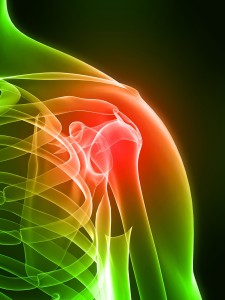Shoulder joint replacement surgery is a great way for those who have loss of normal function to regain use of their upper arm and shoulder.
It may be right for you if you have:
- Moderate to severe pain with rest and this pain prevents you from getting a good night’s rest.
- Severe shoulder pain that interferes with everyday activities, such as dressing and washing.
- Loss of motion and/or weakness of the shoulder.
- Failure to improve with other treatments such as physical therapy, cortisone injections, and medications.

Shoulder Pain
What are some conditions that lead to shoulder pain and disability?
There are several conditions that lead patients to consider shoulder joint replacement surgery. These include osteoarthritis, rheumatoid arthritis, post-traumatic arthritis, rotator cuff tear arthropathy, avascular necrosis, severe fractures, and failed previous shoulder replacement surgery.
Why is shoulder replacement surgery done?
 Your orthopedic specialist may recommend joint replacement when shoulder pain and loss of function become severe and when medications and other treatment modalities no longer relieve pain. Your doctor will use X-rays to look at the bones and cartilage in your shoulder and see whether they are damaged and to make sure that the pain is not coming from another area of your body.
Your orthopedic specialist may recommend joint replacement when shoulder pain and loss of function become severe and when medications and other treatment modalities no longer relieve pain. Your doctor will use X-rays to look at the bones and cartilage in your shoulder and see whether they are damaged and to make sure that the pain is not coming from another area of your body.
Shoulder replacement is not recommended for those who have poor general health, those who have an active infection or are at risk for developing infection, those who have severe osteoporosis, and those who have severe weakness of or damage to the muscles around the shoulder.
How do I prepare for shoulder replacement surgery?
When you decide to have shoulder replacement surgery, your orthopedic specialist will ask you to schedule a complete physical examination with your primary care physician. This is done to make sure you are healthy enough to undergo surgery and complete the recovery process.
In addition, be sure that you talk with your doctors about your medications, as some cause excessive bleeding and should be stopped a week before surgery. Also, make sure you have someone to help you with your activities of daily living after the procedure and someone to drive you to and from the surgical center.
What happens during shoulder replacement surgery?
The upper end of your arm bone (the humerus) is shaped like a ball. Ligaments and muscles hold this ball against a cup-shaped part of the shoulder bone. The orthopedic specialist will replace the top of the upper arm bone with a long metal piece that has a rounded head.
He will also smooth the cup-shaped surface of your shoulder bone and then cap it with a plastic component. The shoulder joint components will be held in place with a special cement or they may be made with material that allows new bone to grow into the joint component over time to hold it in place.
You will be under general anesthesia for this type of surgery, meaning that you will be unconscious during the procedure. There are some surgeons who prefer to use regional anesthesia, however, which means you can’t feel the area of the surgery and will be awake during the procedure.
The choice of anesthesia will be made depending on what you prefer and your doctor’s preference. Right after the procedure, you will be given antibiotics through an IV to reduce the risk of infection.
Find OSS on Facebook and follow on Twitter to keep up to date on new articles and news.

